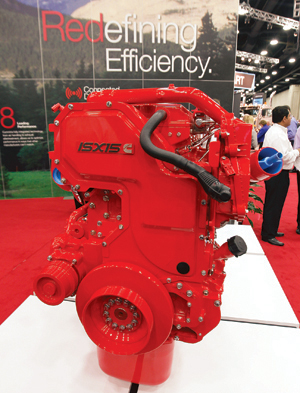Cummins to Revamp ISX15 Engine to Meet Federal 2017 GHG Rules
 John Sommers II for Transport Topics
John Sommers II for Transport TopicsThis story appears in the March 30 print edition of Transport Topics.
LOUISVILLE, Ky. — An updated Cummins’ ISX15 diesel engine will be among the new products the independent engine maker plans to introduce in 2017, the year the federal government will next tighten greenhouse-gas emission ceilings, the company announced here.
Just prior to the start of the Mid-America Trucking Show, Cummins executives said the new ISX15 will be joined by the EcoFit Single Module, an aftertreatment system for heavy- and medium-duty trucks that combines selective catalytic reduction and a diesel particulate filter in one system.
Cummins sells more heavy-duty diesel truck engines in North America than any other single manufacturer, but its market share has been slowly dwindling as truck makers — especially Daimler and Volvo — benefit from vertical integration.
SHOWBUZZ: Complete MATS coverage
PHOTOS: Main | Scene | Trailers | Suppliers | Trucks | Engines and transmissions
MORE PHOTOS: Recruiting | Health | PKY Truck Beauty Championship
Dave Crompton, president of Cummins’ engine business, said the Columbus, Indiana-based manufacturer will keep advancing aggressively to offer new products.
“We have every intention of investing to maintain our leadership,” Crompton said at the March 24 event. With changes in federal environmental policy adopted since 2010, there is an opportunity to develop the most efficient engines possible, he said, and the results have been engines that provide savings on fleets’ fuel bills and reduce carbon dioxide emissions to help the environment.
“This plays to our advantage,” Crompton said.
Through 2010, the U.S. Environmental Protection Agency focused its truck-related efforts on reducing emissions of nitrogen oxide compounds and particulate matter.
EPA and the National Highway Traffic Safety Administration established standards for 2012-2016 model year vehicles on April 1, 2010. The agencies also issued a final rulemaking with standards for model years 2017 through 2025 on Aug. 28, 2012.
Over the lifetime of the 2017-2025 standards, “this program is projected to save approximately
4 billion barrels of oil and 2 billion metric tons of GHG emissions, with net benefits up to $451 billion,” according to EPA.
The new ISX15 will be available in a broad range of horsepower ratings from 400 to 605 hp. It will come in two packages: one for fleets particularly interested in mileage and another for truck operators with high-performance needs, said Jim Fier, vice president of engineering for truck engines.
Fier said the new 15 will get a new “combustion recipe,” or better fuel atomization, and will eliminate some parasitic losses to help meet the new standards, about 3% tighter than the current ones set in 2014. He also mentioned friction reduction and improvements to lubrication and cooling systems as leading to overall fuel-economy improvement.
Single Module is a product from the company’s emission solutions division. Compared with the current setup for selective catalytic reduction and diesel particulate filters, Fier said, the module will be 60% smaller and 40% lighter, yet also more efficient.
This would return highly desired weight and chassis space to truck makers.
As for diesel particulate filters, which were introduced in 2007, Fier said there have been improvements in two areas: Less soot gets to them now during the course of normal operations, and the catalyst materials are better. Combining those two, he said, means a new DPF now needs to be cleaned after 400,000 miles, a significant improvement over earlier models.
Fier was promoted to vice president from executive director, just as Amy Boerger is the new vice president of the North American engine business. The moves dovetailed with the Mid-America Trucking Show.
Boerger recalled for reporters that Cummins has a customer care program, enabling its chain of 3,500 dealerships in the United States and Canada to efficiently address customers’ engine problems. She used the word “uptime,” which has been a mantra among truck makers lately.
With its Connected Diagnostics program, as soon as a Cummins engine throws a fault code, the event is transmitted to Cummins, as well as to the fleet’s office, via the carrier’s standard choice of in-cab communications.
There is an immediate evaluation of whether the problem is so severe it will incapacitate the engine, Boerger said, or whether it is something that can wait a day or more.
“We’re managing uptime for our customers,” she said.
Cummins had 2014 global sales of $19.2 billion, and 56% of that revenue came from the United States and Canada.
Crompton said the company is changing over time, perhaps, because of heavy investment in engine making by truck manufacturers. The days of judging his company based solely on sales of heavy-duty engine likely has passed, he said.
“There’s overall growth, and we’re still adding a lot of value . . . but we may not look exactly the same as in the past,” Crompton said. “Now we’re also in SCR, components, filtration and midrange engines.”
Asked about the California Air Resources Board and its state goal of cutting nitrogen-oxide emissions even further than the 2010 level, Fier said that Cummins is “investing to get to that level, but right now, the technology is not out there.” He said the company continues to work with CARB and other environmental regulators.

